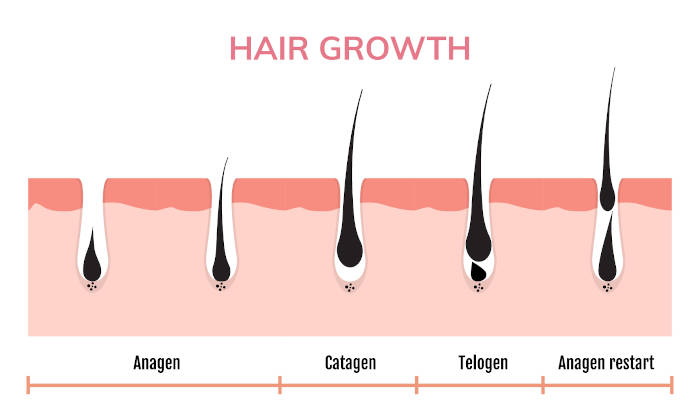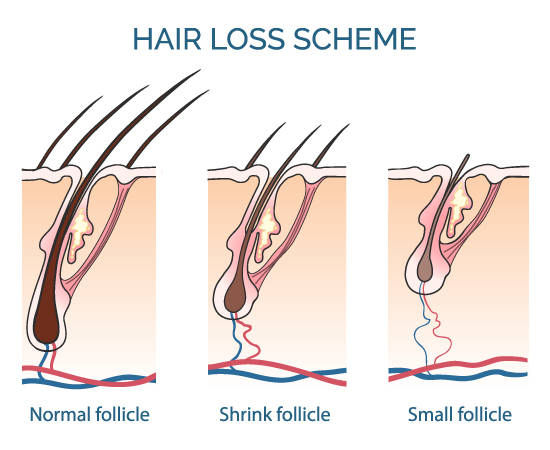Hair Growth and Hair Loss
Phases of Hair Growth
There are three phases of the hair growth cycle (see Illustration).
- Anagen is the active hair growth phase
- Catagen is the regression or active hair loss phase
- Telogen is the resting, or quiescent, phase of the hair cycle.
In the non-balding scalp up to 90% of the hair follicles are in actively growing, anagen phase. This period could extend to 3 years. 1-2% of hairs are in the catagen phase which usually lasts 2-3 weeks. The hair is slowly separating from the dermal root and is held on by a thin strand of connective tissue. 10-14% of hairs are in the telogen phase, which usually last 3-4 months. The attachment further thins, and the hair ultimately falls out.
The cycle lengths vary by location on the body. For eyebrows, the cycle is completed in around 4 months, while it takes the scalp 3–4 years to finish (see Table). This is the reason eyebrow hairs have a fixed short length, while hairs on the head grow to longer lengths. Growth cycles are controlled by a signaling chemicals, such as epidermal growth factor, and are affected by medical conditions and enhanced with non-surgical treatments, such as PRP, low level laser therapy, supplements and medications.

Hair Growth Cycle Times by Body Area
|
Body Area |
Anagen |
Catagen |
Telogen |
|
Scalp |
2-3 years |
2-3 weeks |
3 months |
|
Eyebrows |
4-7 months |
3-4 weeks |
9 months |
Phases of Hair Loss
There are many conditions which transform terminal (thick and healthy) hair into vellus (thin and fine) hairs. The AR Gene, an autosomal gene on the X chromosome, is principally responsible for coding for the Androgen Receptor protein. The gene is passed from the mother’s side. This protein helps hair follicle cells detect and respond to androgen hormones (testosterone and dihydrotestosterone (DHT)). With the onset of puberty in men, elevations in androgens stimulate the conversion of terminal hairs into vellus hairs (see Illustration). The extent this leads to male pattern baldness is genetically determined.
Androgenic hormones (testosterone and dihydrotestosterone) are found in both men and women. Testosterone is required to stimulate beard, axillary (underarm) and pubic hair growth, but not scalp hair growth. DHT however will lead to the miniaturization and loss of susceptible hairs, such as those located on the front, top and crown areas of the scalp. Non-susceptible hairs located on the sides and very back of the scalp, do not shed in response to DHT. This area is known as the safe donor area from which hair follicles may be harvested for transplantation.

Experience Healthy, Thicker Hair
"*" indicates required fields
